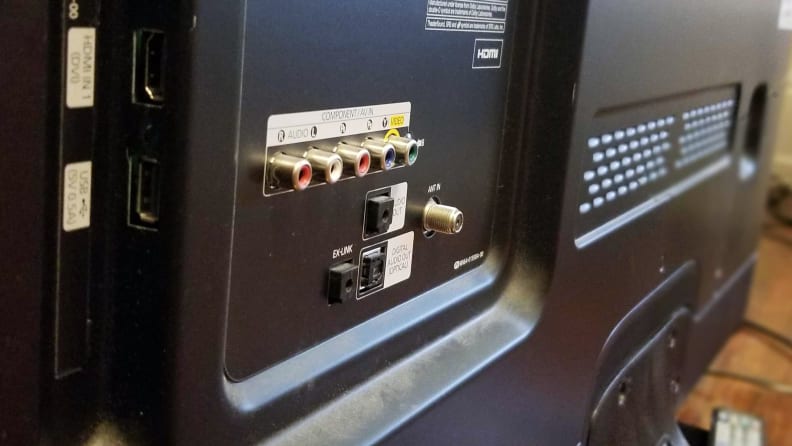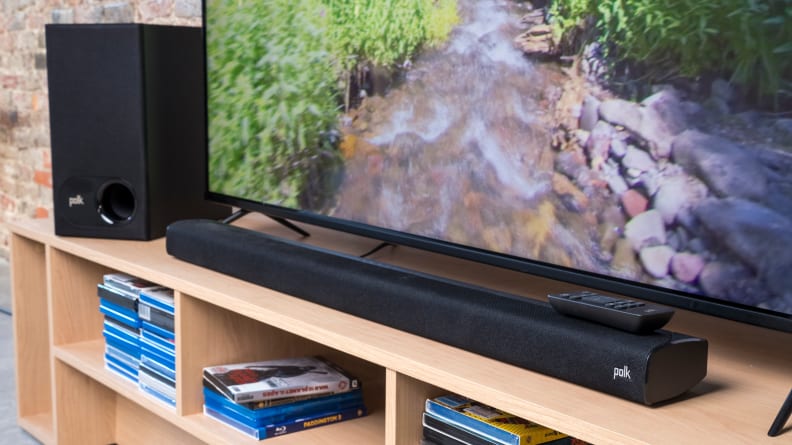Your TV doesn't have enough bass—here's how to fix that
Most modern TV speakers are bad, but you don't have to settle
Products are chosen independently by our editors. Purchases made through our links may earn us a commission.
TV picture quality has gotten better and better over the last decade, but TV sound quality has only gotten worse. As TVs get thinner and more compact (looking at you, OLED), the room inside the TV's chassis has shrunk—and with it, the size of the speakers you're getting in your TV.
While you can fix this simply by investing in a soundbar, it isn't going to give you movie-quality sound. Why? Because even the best soundbars are going to lack bass, something you get in droves at a movie theater.
If you want a super simple fix that'll feel a little more like you're at the movies, just get a subwoofer. You don't need to know all about surround sound audio systems to set up a hefty bass sub–it's easier than ever these days. Here's what you do need to know.
How do I connect a wired subwoofer to my TV?
While many subwoofers these days are wireless, the wired versions are more affordable, but they'll require you to know which port to plug into. Most TVs have a standard set of audio "out" ports (meaning the sound is coming from your TV, out to a speaker, and in to the room), and you'll find them right alongside the HDMI and video ports on the back (or side) of your TV.
The most common audio out ports include:
Optical audio out: Almost every modern TV has this kind of audio output jack. These cables use fiber-optics (hence the name) and laser light to transmit an audio-only signal between devices (you can read a lot more about optical audio over at HowToGeek). Most high-end soundbars that include a subwoofer will plug right into this simple jack. If you're just adding a solitary subwoofer, though, you may need to use something else.
L/R or AV/RCA audio out: This is less common on TVs today, but these left/right channel plugs are essentially the same red/white plugs you used to use to hook up older equipment like game consoles and video, without the yellow "video" part. These are sometimes just included alongside component video/audio out section, and you may need to go into your TV's menu to tell it to output sound this way. There are also many TVs that don't have this port at all, so if your subwoofer of choice only has these ports you might need to hook it up to a receiver or something more complicated.

You'll find a standard set of audio out ports (most often optical audio out and AV audio out) on the back/side of your TV.
HDMI Audio Return Channel: HDMI ARC (for Audio Return Channel) is another very common sight on modern TVs. While it will look like a standard HDMI input, the Audio Return Channel (often labeled "(ARC)") can be used to send incoming audio to a separate, standalone audio source.
This is another one that's more likely to be used with a soundbar/subwoofer pair. Essentially, you'd connect devices as normal, then use an HDMI cable with the ARC-labeled input to send the audio to another device. So if your Roku is plugged into HDMI 1, you might hook up your soundbar/subwoofer pair to something like "HDMI 5 (ARC)" and tell the TV to output sound that way.
Though pretty much all the TVs we recommend these days have one of these ports, it's important to figure out what you have before buying a wired subwoofer, since it won't work if you can't hook it up. If you don't want wires at all, then you'll want to look into a wireless subwoofer...
How do I connect a wireless subwoofer to my TV?
Most of the time, a wireless subwoofer will connect to something like a soundbar or a receiver, so you just have to connect that device and the sub will take care of itself.
In some cases you may need to connect a wireless subwoofer via Bluetooth. This pairing process should work just like any other Bluetooth device, but the steps will vary from device to device and TV to TV. In most cases it'll mean putting your speaker in pairing mode, going to your TV's menu, and having it scan for Bluetooth devices to connect to.
Though not every modern TV has Bluetooth, most of our favorite models do. Most of the time, though, you just hook up the soundbar or receiver by an HDMI or optical audio cable and follow the basic setup instructions.
Which subwoofer should I get?
Though you may want to just get a subwoofer to add some more bass, in most cases we think it's a better option to opt for a soundbar that comes with a subwoofer. Unless you're designing a multi-speaker stereo system with a receiver, these combos are effective and affordable—even compared to just buying a single high-quality subwoofer. Here's why you might also want to grab a soundbar.
For example, if you bought Polk Audio's highly rated standalone subwoofer from Amazon—the 10-inch, powered PSW10—it would run you $130. That's not bad if you are already investing in a receiver, satellite speakers, and everything else you need. But for a little more money you can get one combo that will take care of everything for you.
That's where soundbar/sub combos come in. Though in side-by-side comparisons I wouldn't expect the subwoofer included with the Polk Audio Signa S2 to be quite as good as the PSW10, you can get the whole shebang for around $150 online. The Signa S2 took our top spot when we checked out The Best Soundbars Under $200, and for good reason: it's an easy way to drastically improve the audio quality of any TV, including adding more bass.

If you're hoping to add a wireless subwoofer to your sound system, the most practical solution is to buy a soundbar/subwoofer combo.
The Signa S2 also takes nearly all the headache out of setting up speakers. While you may need to find a good spot for the sub and make a few tweaks, the sub and soundbar come pre-paired right out of the box, so you don't have to worry about running (and especially hiding) wires.
With the Signa S2, you'll still need to connect with the included soundbar via an optical or HDMI (ARC) connection, but these are standard ports that are easy to find on your TV, and both cables are included in the box. Other than power, you can have the whole thing running with just one cable.
If you're looking for a no-nonsense way to get more bass from your TV time—whether it's for movies, sports, or video games—a soundbar that includes a subwoofer is the way to go.
What if I already have a soundbar?
If you've already got a soundbar, we suggest contacting the brand that makes it. Most newer soundbars have Bluetooth already, and there is probably a standalone wireless subwoofer you can buy to pair with it.
Do I have to buy a subwoofer to get better bass?
If you're working with stock TV speakers and don't want to spend much to get at least a little more bass or lower midrange presence in your movies and music, you don't have to buy a combo system.
Something as affordable as the Vizio SB2920-C6 (at the moment, less than $80) will still provide huge improvements over your stock TV speakers. You won't get deep "sub-bass" frequencies, but you'll hear things as low as 70 or 80 Hz, which is digging a lot deeper than your TV's dual 20-watt speakers.
Do I HAVE to buy another product to get better bass?
Not necessarily. If you go into your TV's settings menu, you can usually pick from various sound modes, such as "Standard" or "Movie" or "Cinema." Many times, movie or film-focused modes tend to emphasize bass and lower midrange frequencies a bit more. Obviously this won't come near replicating a soundbar experience, but it's better than "standard" mode, probably.
Another thing you may be able to do on midrange and higher-end TVs is adjust the EQ curve directly. That means manually tuning frequencies (like 60, 80, or 100 Hz) to add more bass presence. While this isn't the worst way to get more boom boom, it will come at the expense of the speaker driver's ability to emphasize other frequencies, so it's still not on the level of just getting a soundbar/subwoofer combo.
